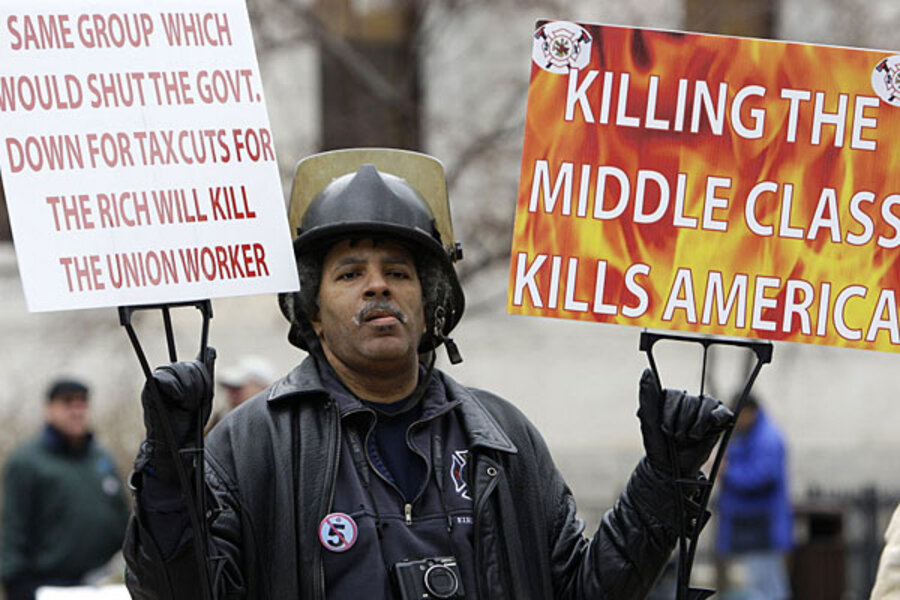Ohio poised to limit collective bargaining. Will such moves save money?
Loading...
| Chicago
It’s a familiar scenario these days, this time in Ohio: The Republican-led legislature is moving forward a bill this week that would erode union strength. Democrats and labor advocates are up in arms, saying the bill is an attack on the middle class, while the Republican governor insists the measures would help address a massive budget deficit.
Indeed, the Midwest is becoming a battleground over the effectiveness – or not – of policy that targets the union representation of public-sector workers.
So far, in states where union-related bills are moving through the legislative process, tensions remain high and resolutions are not clear-cut. The high-profile battle in Wisconsin over collective-bargaining power is moving through the state’s court system following an almost-two-month battle. Indiana legislators just ended a five-week standoff between the political parties that resulted in compromise versions of bills aimed at curbing union representation.
The Ohio House passed collective-bargaining legislation on Wednesday, and the bill heads back to the Senate for another vote. Gov. John Kasich (R) promises he will sign the bill into law next week, but already there is a referendum movement afoot.
“It’s a totally open question” whether limiting collective bargaining will actually help states shore up budgets over the long term, says Eileen Norcross, senior research fellow at the Mercatus Center at George Mason University in Arlington, Va.
Just because a state enacts measures that limit union power does not necessarily mean a cost savings, Ms. Norcross adds. Unions “have other tools available to them to achieve the same goal as collective bargaining,” she says, such as lobbying for candidates who are sympathetic to their cause or pushing for referendums to change policy.
“It’s not the collective bargaining; it’s the political power of unions that has the effectiveness. That calls into question whether altering collective bargaining gets the policy reformers to where they imagine they want to go,” she says.
Certainly, collective bargaining is at the forefront of many state budget agendas because of newfound political will. The November midterm elections resulted in a number of new Republican governors and turnovers in party majorities at the statehouse level, and the new officials believe that “they have the political capital” to make cuts according to how they see fit, says Leslie Scott, director of the National Association of State Personnel Executives in Lexington, Ky.
Their arrival in power comes during a perfect storm of historic budget shortfalls, rising costs, and depressed revenues.
Federal stimulus money, used as emergency relief during the recession, is ending. In fiscal year 2010, states took in a total of $68 billion in federal relief. However, only about $6 billion will be left by fiscal year 2012, the same year when total budget shortfalls are expected to reach about $125 billion, according to the Center on Budget and Policy Priorities, a nonpartisan think tank in Washington. This means that federal dollars will cover only 5 percent of the gap.
Besides cutting infrastructure projects and reducing funding to public education and local governments, state officials have made the public sector a prime target of budget reform. At least 39 states are proposing cuts to public services, according to data compiled by the Center on Budget and Policy Priorities. About 450,000 state and local government jobs have been cut since August 2008.
Cuts this deep may end up working against the future economic health of the states, warns Adam Looney, policy director of the Hamilton Project at the Brookings Institution in Washington.
“[Cuts to the public sector] can be expedient when faced with an admittingly horrible budget situation. But there will be a cost in the long term because the benefits are, in some ways, harder to visualize,” Mr. Looney says. “State and local governments educate the nation’s children, and they build infrastructure. Those are the things that have long-term benefits. That’s one big consequence of this round.”
Ms. Scott worries that public-sector cuts, such as for collective bargaining, may make it harder for states to find new employees. Such workers may decide the private sector is more secure and has greater benefits.
Some cuts may also threaten retaining workers who are skilled in emerging technologies. State employee levels will be further depleted over the next five years, when 30 percent of that workforce is eligible to retire.
“You’re going to have a decimated state government workforce,” she says. “You’re still going to need managers and analysts to carry forth the work. But it’s hard to plan when you’re faced with the reality of cutting your budget by millions of dollars.”





